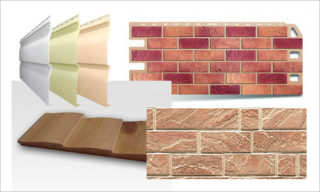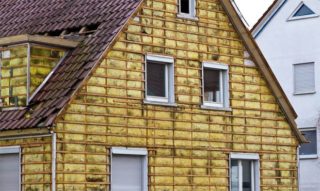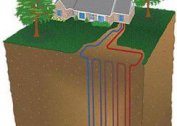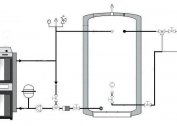Sheathing of a residential building with siding is becoming increasingly popular due to the low cost of the necessary materials, the practicality and aesthetic appearance of the finished buildings. To sheathe a house with siding with insulation with your own hands, it is enough to choose the appropriate type of insulation, as well as study the step-by-step instructions that include all stages of work.
Varieties of siding and their characteristics
Siding is a panel designed for decoration of building facades and additional structures. In addition to the decorative function, such panels are used as part of a multilayer wall covering, which is created as a waterproofing. They reduce noise and help improve the performance of the building. A large number of types of such cladding are on sale, each of which has its own characteristics.
Wood-polymer composite
Composite panels are manufactured using technology that includes a method of pressing under the influence of high pressure and temperature. The composite fibers are bonded using special resins, boards for additional resistance and durability are covered with a layer of paints and varnishes. This kind of siding has many advantages, including environmental friendliness of the material, resistance to low temperatures and the absence of problems during installation. The list of disadvantages of a composite of wood includes high cost, shortened service life, as well as the need for special care.
Metal sheet
The basis of this type of canvas is metal, coated with soil in combination with a polymer material. Metal siding can be steel, aluminum or galvanized. Most often it is used as a facing coating for public buildings and commercial buildings. Due to the high cost, this material is rarely used in individual construction, but is well suited for the construction and quick repair of high-rise buildings. The list of its advantages includes low weight, low combustibility, increased strength and long life.
Fiber cement slabs
Fiber cement boards are made from a mixture containing cement, cellulose fiber and water. This is an environmentally friendly siding with good decorative properties, due to which it can replace an expensive stone for decoration. It is characterized by ease of installation, has a natural appearance, is not subject to corrosion and the development of biological organisms. Fiber cement slabs are resistant to precipitation, do not burn and do not require special care. This facade material has practically no drawbacks, but it is rarely used in Russia.
Lining and analogues
Lining made of PVC and vinyl siding are considered the most popular options for cladding, as they are suitable for brick houses, as well as for buildings made of wood or timber. Both materials differ in the specifics of manufacturing, the method of installation and fastening. Both types of siding are based on polyvinyl chloride - a colorless plastic that is resistant to acids, alkalis, mineral oils and solvents.
As part of vinyl siding, there is titanium dioxide, which is absent in the lining. It makes the material more durable, fixes its dye and protects the surface from the influence of the external environment. The vinyl finish withstands temperatures from -50 to +50 degrees.The composition of the lining, in addition to the main components, includes chalk, due to which it is a more environmentally friendly material, but at the same time less durable due to the cellular structure.
Plastic products
Plastic cladding panels are popular because of their low cost and quality, not inferior to more expensive counterparts. Plastic cladding makes the appearance of the facade more accurate and protects it from environmental factors. It is a strong and durable material with high incombustibility, resistant to moisture and not causing problems in the care process. It does not emit substances harmful to health, it is easy to mount, it also has a small weight.
Selection of insulation materials
Before wall cladding, it is worth taking care of thermal insulation. Without insulation on the walls, dampness and fungus can form, for this reason it is advisable to carry out the installation of siding with heat-insulating material. This installation method allows you to save the decorative properties of the facade. When choosing a material, you need to pay attention to such points:
- thermal conductivity should be kept in the range from 0.03 to 0.045 W / M K;
- optimal stiffness of the material and preservation of its shape;
- hygroscopicity level;
- low flammability and resistance to decomposition.
Most often, experts use several types of materials, the list of the most popular includes mineral and ecowool, as well as polyurethane foam.
Mineral wool
Mineral wool is a pressed square or rectangular plate of regular shape, made of basalt fiber by melting. For greater strength, phenol-formaldehyde resin-based components are added to their composition. To improve the environmental friendliness of mineral wool, the plates are subjected to heat treatment in order to neutralize phenol. Minvata is one of the most common materials, its thermal conductivity is 0.036-0.041 W / M-1 K-1, and its strength is 0.05 kg / cm2. It absorbs moisture with a percentage in the range of 1-1.5%, has a flammability class of NG and is not affected by mold and microorganisms.
Polyurethane foam
Polyurethane foam consists of polyol and isocyanate, these components react and form a foamed mass, which exceeds the initial amount of substances in volume. The coefficient of thermal conductivity of polyurethane foam varies between 0.019-0.028 W / M-1 K-1, the strength is 0.15 kg / cm2, the combustibility class is G1. Polyurethane foam is not susceptible to mold and microorganisms, and is also chemically neutral.
Ecowool
Ecowool is made from recycled cellulose with the addition of boric acid and potassium tetraborate, which prevent the development of microorganisms, fungi and mold. The thermal conductivity coefficient of the material ranges from 0.036-0.043 W / mK, the density is 25-90 kg / m3, the heat resistance category is G2. Vata is characterized by optimal sound insulation, low density and perfect penetration.
Do-it-yourself preparatory work
First of all, you need to prepare the walls for installation, put a vapor barrier and fix the crate, lay the insulation, install the waterproofing and the siding itself. It is important to avoid common mistakes at all stages of installation:
- Rare installation of frame profiles. Saving material over time will lead to a deflection of the casing, it must be fixed in steps of at least 50-60 cm.
- Lack of counter-lattice. If cotton slabs are used as insulation, they can not be pressed artificially with waterproofing, this can provoke the effect of a quilt, uneven coating, trough and bending.
- Avoiding the use of a level or mooring cord for a more even installation of trims. Houses, the decoration of which is carried out at a level below the embedded part, have irregularities over the entire surface.
As a heater, it is recommended to use basalt cotton wool, which is considered the cheapest and most environmentally friendly product with non-combustible properties. It is hygroscopic enough, therefore, waterproofing and installing siding on cotton wool pass with perfect tightness. If there is a risk of dampness, it is better to use styrofoam, polyurethane foam or penofol instead of cotton wool.
Sheathing of a house from a bar

It is necessary to start warming a house from a bar with the preparation of walls, which are checked for the presence of fungi, mold and microorganisms. Problematic areas must be cleaned or sawn, then the prepared surface is treated with special impregnations from moisture, mold and fire. When installing the battens, it must be taken into account that the guides from the timber can only be installed horizontally or vertically, since the battens themselves are a kind of ventilation for the facade.
Sheathing of a wooden house
At the preparation stage, the main material of the walls must be freed from the old cladding, dust and dirt. Places affected by rot or mold are cut off and cleaned with sandpaper until clean wood appears. Each site is carefully inspected, even a small number of microorganisms located under the siding can damage the finished building. After the cleaning step, the walls are lubricated with antiseptic impregnation and covered with a waterproofing membrane with a vapor-permeable effect. The film should be installed the right side, then it is fixed with a frame.
Frame installation
Before you start siding the structure with siding, it is necessary to form a frame or crate, which can be made of metal or wood. The metal frame resembles profiles for drywall and can be fixed to the wall with suspensions. The wooden crate is fixed to the wall using self-tapping screws or suspensions. When installing the crate, you must observe the distance and fill the frame evenly.
It should be borne in mind that the metal frame will be less rigid, so it must be reinforced with horizontal jumpers. If there is a metal profile, you can choose a heater of any width by making holes for suspensions in it and in the vapor barrier film. This design avoids the bridges of cold, it is suitable for insulation of walls made of timber, brick and concrete. A wooden crate is made in several stages:
- The bars are fixed on the main crate, the thickness of which should coincide with the thickness of the material for insulation.
- Insulation plates are placed in the space between the boards.
- From above, the structure is sheathed with a film for vapor barrier and a counter-crate is made, then siding is installed.
Installation of the battens begins from the corner of the building structure, carefully calculating the fastening step and adhering to it. Given the strong winds, the ideal pitch of the frame will be 40-45 cm. If this value is exceeded, the siding will rattle, its service life will be significantly reduced. First of all, they fix the corner strips and pull the fishing line between them, then additional rails are attached.
At the installation stage of the frame, you can easily eliminate the existing curvature of the walls. For this purpose, suspensions are attached to the base, on which metal profiles of a vertical type are fixed. The ends of the suspension must be bent to the side. In this case, finish and insulate the walls will turn out as evenly as possible.
Laying and installation
Sheathing of a wooden or brick house with insulation requires utmost attention both at the preparation stage and during the installation process. To work, you need to prepare the panels themselves, as well as the start and finish trims, platbands, internal and external corners, and decorative trims. First of all, you need to set the starting bar, which is fixed to the crate with the help of screws, brackets and nails. The rest of the siding sheets should overlap the fastening areas, work starts from the bottom, moving up.
After fixing the initial plank, they begin to fix the first siding sheet. Due to the locking system, the starting bar is easy to attach to the sheet, then it is attached to the crate and proceed to the next row. The material must be secured from the center to the edges using nails or staples placed in the central slot. If the material expands under the influence of temperature, it will begin to move, but will not deform. The hats of nails or self-tapping screws cannot be deepened or twisted, otherwise it will not move.
The panels need to be built up, observing the distances between them with an interval of 5-7 mm, if the installation is carried out in the summer, and 12-15 mm in the winter. The process is carried out until the complete installation of all elements and cladding of the entire house. The insulation is fixed by pressing it between each rail, it is additionally manually strengthened with dowels with wide caps. Thermal insulation materials are overlapped with a waterproofing film, bending its edges inward. A wood frame is mounted on all battens of the crate, on which decorative cladding is placed.
After the decorative decoration is installed outside the building, the installation of the remaining finishing elements and communication equipment, including drainpipes and other details, is carried out.









